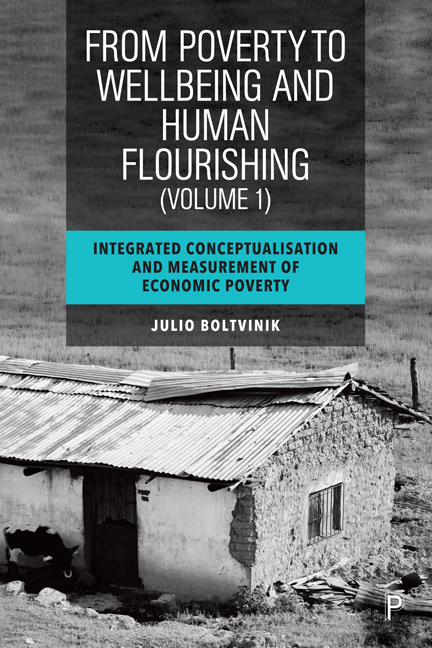 From Poverty to Well-Being and Human Flourishing
From Poverty to Well-Being and Human Flourishing 4 - Principles and good practices of poverty conceptualisation
Published online by Cambridge University Press: 28 March 2024
Summary
4.1 Introduction
Poverty measurement must be multidimensional because HN are multiple. For example, Maslow’s scheme (1943, 1954/1987) includes seven N, while that of Max-Neef et al. (1986) includes nine. Each N is met through various S (the typology of S presented in this book includes seven types; see Section 1.3) to which people have access through a range of resources or WBS (see my typology of six WBS in Section 1.2). This enormous diversity and complexity would not imply heterogeneity for the purposes of analysis if markets were unlimited, that is, if everything were bought and sold and had a price. But this is not the case. Markets have limits, and exchange values are not universal: many S cannot be acquired in the market. Money can neither measure nor buy everything. Some S and WBS cannot be expressed monetarily.
Therefore, the indicators we use to measure multidimensional poverty are either nominative indicators that can always be transformed into ordinal ones, or else cardinal indicators. This heterogeneity requires a solution to combine all the dimensions involved. Some solutions present in the literature are highly problematic and involve inconsistencies, and most of them lose much of the available information by adopting dichotomic indicators.
This chapter and Chapter 5 establish principles (Pr) and good practices (GP) that pave the way for better solutions to the problem of heterogeneity, as well as to many other problems I have found in PMM used worldwide. While this chapter broaches what I have called principles (Pr) and good practices (GP) of poverty conceptualisation (PPC and GPPC, respectively), Chapter 5 discusses Pr and GP of poverty measurement (PPM and GPPM). The boundary between conceptualisation and measurement is fuzzy, but the division seems quite useful. Although I had not stated them in written form, some of these Pr and GP have guided me in the multidimensional measurement of poverty I have been practising (and preaching) since 1990. Others, I have developed recently, partly as a response to a number of queries raised among some authors regarding my multidimensional measurement method, the IPMM.
- Type
- Chapter
- Information
- From Poverty to Well-Being and Human FlourishingIntegrated Conceptualisation and Measurement of Economic Poverty, pp. 81 - 94Publisher: Bristol University PressPrint publication year: 2023


